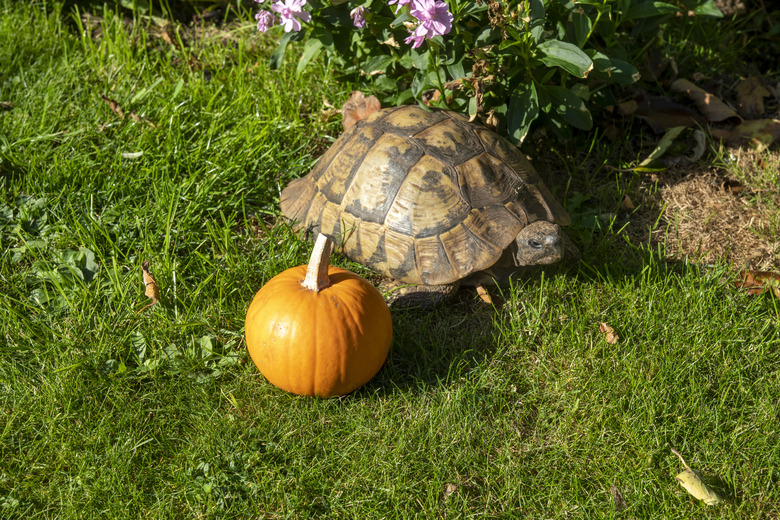What Do Land Turtles Eat?
Most land turtles are called tortoises, and they are herbivores, meaning their diet consists primarily of plant material. The best tortoise foods are plants and grasses found where they live. That doesn't mean that owners of pet tortoises who don't live near their native habitat have to send for special food, but you shouldn't feed pet turtles your table scraps either. Some land turtles, like box turtles and wood turtles, are not tortoises, and they have different diets.
How to tell turtles from tortoises
How to tell turtles from tortoises
Turtles who live only on land are usually called tortoises, although they are still turtles too. Turtles are reptiles whose bodies are encased in a bony shell, and that describes tortoises as well as other turtles. However, tortoises and turtles have some features that let you easily tell them apart. Turtles have front limbs that resemble flippers and back feet that are webbed. Tortoises' front limbs have claws, and their back legs look like columns, which is called elephantine. There are, however, exceptions to the tortoise vs. turtle identifying features.
Land turtle food
Land turtle food
In the wild, a turtle's diet depends on where they live. Desert tortoises eat cacti and other succulents, desert grasses, and flowers. Tortoises in forest wetlands modify their diet according to the seasons. During the wet season, they eat succulents, grasses, herbs, and shrubs. When it's dry, they look for dry plant material and rabbit feces.
Plant material should be at least 80 percent dark, leafy greens, like kohlrabi, turnip greens, and collard greens, but you can also offer colorful vegetables, like bell peppers, dandelion, and green beans as well as flowers, grass, and hay. Swiss chard, beet greens, and spinach contain oxalates that can interfere with calcium absorption, while cabbage, mustard greens, and kale can cause hypothyroidism, so feed all of these sparingly.
Whatever you feed them, don't feed turtles on gravel or dirt, as they can then ingest some of that material, which is not good for them. Be sure to also provide a clean dish with water. Many turtles like to bathe in it as well as drink some of the water. Wash the dish and change the water daily because some turtles will also use the dish as a potty.
Feeding box turtles
Feeding box turtles
Box turtles are land turtles with front and back claws, but they are not considered to be tortoises even though they do not live in water. They are the only turtles that can completely close their shells. If you thought all turtles could do this, that's because box turtles are very common. In fact, turtles found outside anywhere from the Midwest to the East Coast and all the way to the South (though not in the ocean) are most likely Eastern box turtles. They are sometimes called by different names depending on where they are, like the Florida box turtle or the Gulf Coast box turtle.
Unlike tortoises, who are herbivores, box turtles are omnivores; they eat both plant foods and animal foods. Up to age 6 or so, they are primarily carnivores, eating meat only, but as they mature into adulthood, they become herbivores and eat mostly plant materials.
Box turtles are protected in many states due to their dwindling numbers, so if you find one in your yard, don't take it as a pet. You can put out or plant healthy food for them to find, though. Feed box turtles a diet that's about 50 percent animal based and 50 percent the type of plants you'd feed tortoises. Many vets recommend lightly sprinkling box turtles' food with calcium powder a few times a week, but ask your vet about this first.
Diet of wood turtles
Diet of wood turtles
Wood turtles inhabit the Northeastern United States and Southeastern Canada and are usually found in wooded areas near open meadows and small streams. In the wild, they forage for berries, mushrooms, insects, fish, tadpoles, slugs, and snails. You may see them from March through October, when they hibernate in burrows or the sides of stream banks as cold weather sets in. You'll recognize wood turtles by their burnt orange skin and brown upper shells. Wood turtles are a threatened species, and taking them as pets is illegal.
Feeding fruit and washing hands
Feeding fruit and washing hands
Tortoises and other land turtles eat fruit in the wild, and they enjoy it. Pet land turtles or tortoises will love any fruit you provide, but it is not good for them in large quantities due to its high sugar content nor is it as nutritious as vegetables. Therefore, make fruit an occasional treat. Serve it only every two weeks or so, offering dark greens and grasses for the rest of their plant materials.
All turtles carry salmonella, which can make humans very ill. Wash your hands with soap and water after touching a turtle, his dishes, or his habitat. Always check with your veterinarian before changing your pet's diet, medication, or physical activity routines. This information is not a substitute for a vet's opinion.
